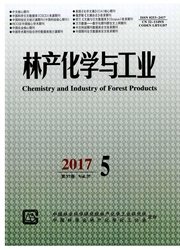

 中文摘要:
中文摘要:
以柠檬酸为交联剂,利用酯化交联工艺将功能主体分子β-环糊精接枝到杨木木粉表面制备β-环糊精/木粉(β-CD/WF)接枝共聚物,并用红外光谱仪、热重分析仪和酚酞探针分子技术进行表征。以Pb^2+为吸附质, β-环糊精/木粉接枝共聚物为吸附剂,系统探讨接触时间、pH值、Pb^2+初始浓度对吸附效果的影响。采用准一级动力学方程、准二级动力学方程、颗粒内扩散模型、Langmuir吸附等温方程、Freundlich吸附等温线方程对试验数据进行拟合。结果表明: β-环糊精不仅被接枝于木粉表面而且可以体现出包合活性;在298 K时, β-环糊精/木粉接枝共聚物对Pb^2+吸附平衡的接触时间为30 min,适宜pH值范围为4~8,平衡吸附量随Pb^2+的初始质量浓度增加而增加; Pb^2+的吸附过程符合准二级动力学方程,即以化学吸附为主,颗粒内扩散不是唯一的吸附速率控制步骤;吸附符合Langmuir吸附等温模型,说明Pb^2+的吸附属于单分子层吸附;吸附的吉布斯自由能变为负值,熵变和焓变分别为54.45 J/(mol·K)和13.75 kJ/mol,即该吸附是能自发进行的吸热过程。
 英文摘要:
英文摘要:
β-cyclodextrin/wood flour (β-CD/WF) grafted copolymer was prepared by esterification- crosslinking technology, i.e. , grafting β-CD onto poplar wood flour in the presence of citric acid. The properties of this grafted copolymer were characterized by FF-IR, TGA and the technique of phenolphthalein probe respectively. The adsorption property of this copolymer for Pb^2+ in a batch adsorption system as a function of contact time, pH and initial Pb^2+ concentration was investigated in this study. The results showed that β-CD was not only grafted onto the surface of wood flour but also demonstrated an encapsulation activity. The kinetic data were analyzed by the pseudo-first, second-order kinetics and intrapartiele diffusion, and the equilibrium data were analyzed using Langmuir and Freundlich isotherm models. The results showed that adsorption equilibrium was reached within 30 rain at 298 K under the proper pH between 4.0 and 8.0 , and the adsorption capacity increased with the rise of initial Pb^2+ concentra- tion. It was found that the adsorption kinetics followed the seeond-Order model. This suggested that the adsorption of Pb^2+ by copolymer was a chemisorption process, and the intraparticle diffusion was not the primary rate-determining step. Besides, Langmuir model fitted the equilibrium data better than the Freundlieh isotherm. It reflected the adsorption of Pb^2+ on eopolymer was monolayer adsorption. The thermodynamic properties,△G, △H and △S showed that adsorption of Pb^2+ onto β-CD/WF flour grafted copolymer was endothermic and spontaneous in the temperature range of 293 -β3 K.
 同期刊论文项目
同期刊论文项目
 同项目期刊论文
同项目期刊论文
 Chelating-Ultrafiltration Treatment of Some Heavy Metal Ions in Aqueous Solutions by Crosslinking Ca
Chelating-Ultrafiltration Treatment of Some Heavy Metal Ions in Aqueous Solutions by Crosslinking Ca Preparation, quantitive analysis and bacteriostasis of solid state iodine inclusion complex with bet
Preparation, quantitive analysis and bacteriostasis of solid state iodine inclusion complex with bet Release characteristics and antibacterial activity of solid state eugenol/beta-cyclodextrin inclusio
Release characteristics and antibacterial activity of solid state eugenol/beta-cyclodextrin inclusio 期刊信息
期刊信息
